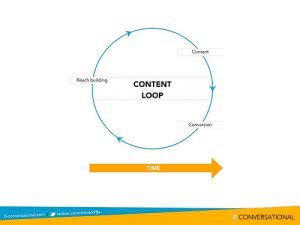Social Media Management
Make Your Social Media Channels More Effective in 4 Steps

A large number of companies are thinking about their next steps in social media. One of the key factors in any social media strategy is the channel/content debate. Companies are struggling to capitalize on their use of social media channels. By means of a hands-on paper, we want to share our approach on how to make effective use of social media channels in order to spread content. This blog post gives a short summary of the paper. The full paper can be downloaded at the end of the post.
The paper is based upon a series of research projects conducted over the last two years, the experience gained from numerous workshops with our clients and an in-depth discussions with social media experts Erik Van Roekel (@evr) and Matthijs Van Den Broeck (@mgvandenbroek).
4 Steps to Effective Social Channel Use
Evolving from a checklist approach to social media towards an effective social channel use requires a different mindset. To build this mindset you need to go through 4 distinct phases:
1. Channel & Content Strategy
The first step consists in formulating a clear vision on the role of each of the online touch points. Apart from defining the goals and content of each of the individual channels, this phase is also about deciding how those channels interrelate. In this phase, you define which touch points are most likely to reach the social media (and broader business) objectives. Instead of creating social silos you are going for an integrated approach where the whole is greater than the sum of the parts.
Most managers think of social media channels as stand-alone silos. Content is spread through each of these channels without a clear plan on how to reach business objectives. The truth is that all online channels are interrelated. Consumers can even be routed from channel A to channel B. In this phase, companies should create a ‘content-conversion’ plan.
A content-conversion plan includes every touch point where a (potential) customer can come into contact with your content. Then you need to determine at which of these touch points conversion to your objectives (reputation management, community building, lead generation…) is likely to occur. All other social channels support traffic generation towards these conversion points. Instead of having a set of silo channels, this creates a set of interrelated online channels.
For example, the converting touch point might be the corporate website or blog. A corporate blog can be the touch point that leads people from the content area to the sales area. Your other social media accounts ensure that sufficient traffic is channeled to the blog every day.
For companies working in the knowledge sector, SlideShare can serve as a useful converting touch point. SlideShare is a social network site where people can share presentations (PowerPoint, etc.). This is the ideal place to showcase what you can do and what you have to offer. On this platform, it is easy to directly convert a reader into a sales lead. In case your key objective is community building, your Facebook page may be the best content-conversion point. When mapping out your conversion touch-point plan, define the trigger for each touch point that makes it possible to move on to the next. Furthermore, try to keep the lines as short as possible. The more steps are necessary in order to reach the touch point where your business goals are realized, the harder it is to achieve high conversion rates.
2. Build reach
To increase the return on content creation, it is advisable to build reach in the early phase of your online plan. In this phase, the hard part is maintaining a balance between relevant content on the one hand and being able to attract a large set of likes & followers on the other hand.
There are two ways to build reach: the slow approach and the fast approach. The slow approach builds reach over time by investing in quality content that spreads naturally. To succeed in the slow approach, you need three things: good content, a fixed rhythm and a lot of patience. Big brands usually lack the last ingredient, which is why we recommend choosing the fast approach. Our research has shown the following seven approaches to be successful reach builders:
- Conversation worthy campaigns: invest in social campaigns to boost the reach of your social channel activities
- Rhythm: a one-time campaign won’t do it. You need a certain rhythm to share great content
- Contests & free stuff: giving away some of your products is still an effective way to build reach in the short run (although there’s no guarantee of quality). Many companies are afraid to attract ‘low quality’ followers with this strategy. This is indeed a risk: once they are on board, the challenge consists in convincing such followers to stay with your content (step 3)
- Social advertising: to grab the attention of your audience, you need to advertise your campaigns and content on social channels.
- Employee activation: a company should always have more fans than employees. If your own employees don’t follow your content, how can you expect your customers to be interested? Train and facilitate employees to become active ambassadors of your social channel activities.
- Offline communication channels: building reach goes beyond online channels. Try to mention online channels in all your communications: TV commercials, print advertising, banners, point of sales material…
- Partner up with other major brands: if you have a good relationship with brands that have a large social reach, you can always ask them to share your brand content (or a competition) with their fan base.
3. Persuasion through content & interaction
Once you’ve attracted a significant number of followers and fans, you need engaging content to keep them interested. The threshold to follow a brand is very low but it takes a huge effort to keep your audience engaged.
Research conducted by InSites Consulting has shown that the average consumer actively interacts with no more than 5 brands on social media. This means your brand needs to be part of this select little group. Also, recent research has shown that fans won’t dislike your page if they don’t like the content; instead they will ‘hide’ your page. This means competing for the attention of your own followers with big love brands like Apple, Coca Cola and Disney. And let’s not forget, your toughest adversaries when competing for the attention of your followers comes are those followers’ friends and families.
The conclusion is obvious: this evolution is raising the bar for companies to be able to engage with consumers on social media.
Three elements are key in this particular phase:
- An editorial calendar: make sure you know what your content updates will look like at least three months in advance. Our previous research paper, ‘a six-step content marketing plan’, outlines how to set up an effective editorial calendar. In fact, content planning consists of three layers: big campaigns (very intense), projects (recurring thematic themes) and content updates (small content sparks).
- Creative content: drawing up the perfect content plan is probably the easiest part of the long road to success on social media channels. Coming up with creative and talked-about content is the real challenge. It’s not an exact science and there’s no such thing as a foolproof plan. It’s really quite simple: building content that conquers the hearts of your followers and friends requires highly creative people.
- Operational conversation management : in this phase, consumer engagement is one of your key objectives. To succeed, you need top operational conversation management. Have a person or a team ready to interact and engage with your audience. Be fast, empathic and listen to your fans so they will commit to your brand. Follow the conversations in real time and be ready to respond.
4. From likes to ambassadors
The final phase is the most difficult part. In this phase you are looking to create a small army of active ambassadors. The previous steps focused on winning people’s hearts through great content. In this phase, the challenge is to create ambassadors: people who promote your brand to their friends and family. Here the question is: ‘What do we want our fans to say about us and how can we facilitate this?’. Succeed in this challenge and you will be rewarded with positive and impactful conversation about your brand.
In this stage, you need to convert your likes into ambassadors. The following factors are essential:
- Broad consumer involvement: if you involve your customers in your decision-making flows, they will be more committed to your brand. People are more emotionally involved when they feel they are part of the team and that’s how you create ambassadors. So content planning is not just about sharing cool content or asking evident questions. It’s also about asking your customers for feedback on your performance. Ask people’s opinion on all things related to your company and remember to thank them for the input they provide.
- Consumer consultants: if you have in-depth questions concerning a new project or product, you should turn to your die-hard fans on social channels and invite them to join a closed community to discuss these topics. This makes them feel like they are really part of the team and essentially you’re hiring employees that are not actually on the payroll.
- Questions and answers: put meaningful questions to your audience as we explained in the first bullet point. Once your fans start giving you inspiring feedback, be sure to return the favor and keep them in the loop. Let them know what you did with the feedback and why certain remarks were used and others were not. Be open about what use you make of their feedback. Gain their trust be being honest.
- Branded utility: think of applications that bring added value to your fans. Look for content that is both highly relevant to your audience and in line with your business. Once again, you need top creative people to invent these applications. Once fans start using the utility apps, it is a great way for them to talk about your brand through the application.
From Four Steps to an Everlasting Loop
These four phases are obviously not entirely sequential; there is an overlap between phases 2, 3 and 4. In our strategy, it’s not that hard to define the necessary actions for the various steps. In real life, though, we need to be flexible enough to adapt to consumer needs in a moment’s notice. Once a certain stage is reached, phases 2, 3 and 4 become iterative steps in an eternal loop designed to build reach and create more ambassadors.

[First published on http://www.theconversationmanager.com/2012/11/19/make-your-social-media-channels-more-effective-in-4-steps/]





